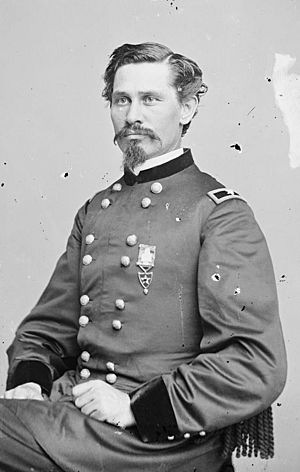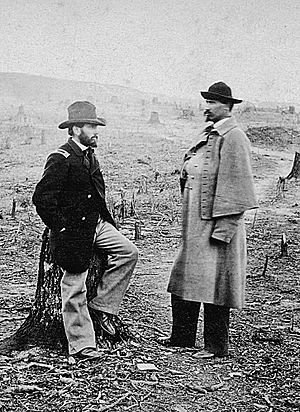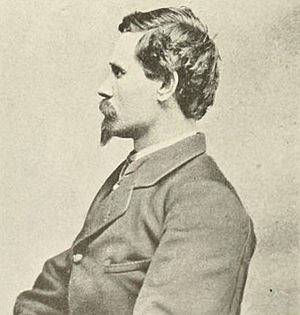Orlando Metcalfe Poe facts for kids
Quick facts for kids
Orlando Metcalfe Poe
|
|
|---|---|

Orlando M. Poe, taken at the end of the Civil War.
|
|
| Born | March 7, 1832 Navarre, Ohio, U.S. |
| Died | October 2, 1895 (aged 63) Detroit, Michigan, U.S. |
| Place of burial | |
| Allegiance | United States of America Union |
| Service/ |
United States Army Union Army |
| Years of service | 1856 - 1895 |
| Rank | |
| Commands held | 2nd Michigan Infantry Regiment |
| Battles/wars | American Civil War |
Orlando Metcalfe Poe (March 7, 1832 – October 2, 1895) was an important American soldier and engineer. He served as an officer in the United States Army during the American Civil War. After the war, he became famous for designing many lighthouses on the Great Lakes. He also helped design the Poe Lock at Soo Locks, which connects Lake Superior and Lake Huron.
Contents
Early Life and Education
Orlando Metcalfe Poe was born in a town called Navarre, Ohio, on March 7, 1832. His parents were Charles and Susannah Poe. He was the oldest of their five children. After attending local schools, Orlando went to the United States Military Academy (West Point). He was a very good student and graduated sixth in his class in 1856.
After graduating, he worked as an engineer. He helped survey, or map, the northern Great Lakes region. During this time, he was promoted to the rank of first lieutenant.
Poe's Family History
Orlando Poe's family came from Germany. His great-great-grandparents, Catherine and George Jacob Pfau, moved to America. Their sons later changed the family name to Poe. The Poe family settled in Ohio. Orlando also had English family roots from his Metcalfe ancestors.
Service in the Civil War
When the American Civil War began, Poe helped organize volunteer soldiers from Ohio. He then joined the staff of Major General George B. McClellan. Poe helped with the Rich Mountain campaign in western Virginia. He also helped organize the defense of the capital city.
In September, he became a colonel in charge of the 2nd Michigan Volunteer Infantry Regiment. He led his soldiers successfully in battles like Yorktown and the Battle of Seven Pines. Later, he commanded a larger group of soldiers, called a brigade. His brigade was at the Second Battle of Bull Run and the Battle of Chantilly. They were also present at the Battle of Fredericksburg in December 1862.
Poe was promoted to brigadier general in November 1862. However, this promotion was not approved by Congress. So, he went back to his old rank of lieutenant in the regular army. Soon after, he was promoted to captain and moved to the Western Theater of the war.
As the chief engineer for the XXIII Corps, Poe played a very important role in defending Knoxville, Tennessee. This city was under attack by Confederate forces led by Lieutenant General James Longstreet. Poe's engineering skills helped the Union army successfully defend Knoxville during the Battle of Fort Sanders in November 1863.
Because of his great work, Major General William Tecumseh Sherman chose Poe to be his chief engineer in 1864. Poe helped supervise the destruction of military buildings in Atlanta. He made sure that anything useful to the Confederate army was taken apart or burned in controlled fires. He was very upset by uncontrolled fires set by other soldiers that damaged civilian homes.
Poe continued to serve as chief engineer during Sherman's March to the Sea. General Sherman himself said that Poe was essential during this march. Sherman's army moved across Georgia without regular supplies, living off the land. Poe's skills were vital for building bridges and roads. This kept the army moving through difficult areas like swamps. He also continued to supervise the destruction of Confederate military resources.
After the fall of Savannah, Poe was given the honorary rank of colonel. He continued his work during the Carolinas Campaign. When the war ended, Poe received another honorary rank, Brigadier General in the regular army.
Post-War Engineering Career
After the Civil War ended in 1865, Poe became the chief engineer for the United States Lighthouse Board. In 1870, he was promoted to Chief Engineer of the Upper Great Lakes 11th Lighthouse District. In this role, he designed and oversaw the building of many lighthouses. These lighthouses are sometimes called "Poe style lighthouses."
Some of the lighthouses he helped build include:
- New Presque Isle Light (1870) on Lake Huron
- South Manitou Island Light (1872) on Lake Michigan
- Grosse Point Light (1873) in Evanston, Illinois
- Au Sable Light (1874) on Lake Superior
- Outer Island Light (1874) in the Apostle Islands
- Little Sable Point Light (1874) on Lake Michigan
- Wind Point Light (1880) in Racine, Wisconsin
- Seul Choix Light (1895) in Manistique, Michigan
- Spectacle Reef Light
One of his most impressive lighthouse projects was the Spectacle Reef Light on Lake Huron. Building it was very challenging due to its remote location and the materials needed. It is considered one of the greatest engineering achievements on the Great Lakes. He also used the equipment from Spectacle Reef to build the Stannard Rock Light on Lake Superior. This lighthouse is also considered a top engineering feat in the United States.
From 1873 to 1883, Poe worked as an engineering assistant for William T. Sherman, who was then the commanding general of the U.S. Army. In 1883, Poe became the Superintending Engineer for rivers and harbors on Lakes Superior and Huron. Here, he helped develop the St. Marys Falls Canal.
Many people believe his greatest achievement was designing and building the first Poe Lock in Sault Ste. Marie. This lock was very important for the shipping industry on the Great Lakes. It helped large freighters carry goods, which was key to the growth of the steel industry in the United States. The original Poe Lock was replaced by a larger, more modern lock in the 1960s, but the new one was still named the Poe Lock in his honor.
Orlando Poe passed away in Detroit on October 2, 1895, due to an infection from an accident at the "Soo Locks." He was buried at Arlington National Cemetery. Poe Reef and the Poe Reef Light in Lake Huron are named after him.
See also
- History of the modern steel industry
- List of American Civil War generals (Union)



